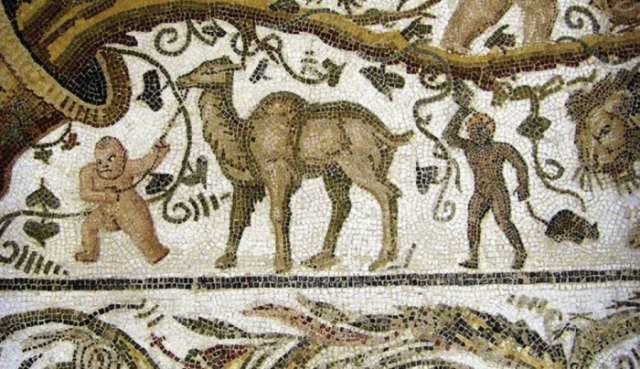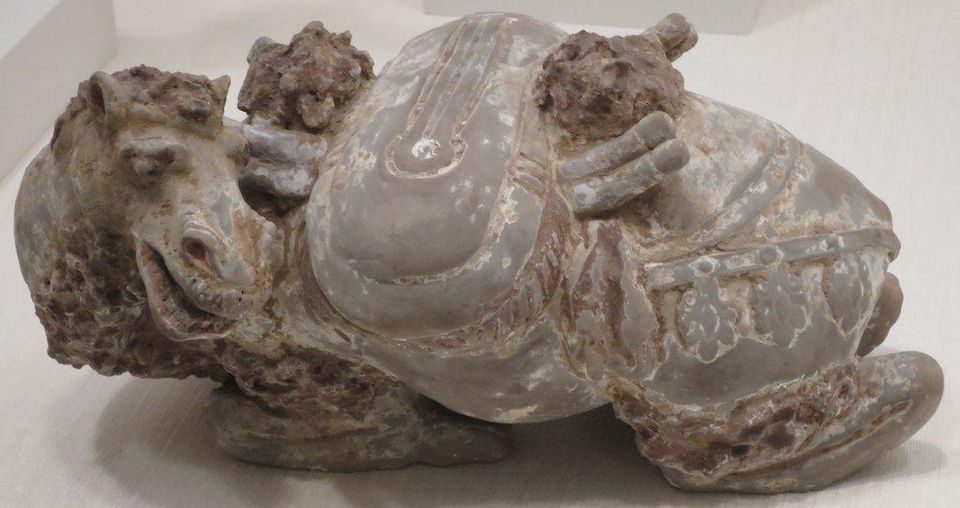
A camel from the 'Mosaic of Silenus' of Thysdrus (El Djem, Tunisia, 3rd c. CE).Wikimedia
Were there camels in Roman Britain? Archaeological evidence indicates that camels were used across the Roman empire
well into the early medieval period. As historian
Caitlin Green suggests, this includes the island province of Britannia.
In Roman antiquity, the camelus (from the Greek word
κάμηλος) could come with one hump or two.
The single humped camel is commonly called a dromedary. The dromedary was usually from the Arabian Peninsula and the African steppe regions. The two-humped camel was the Bactrian camel (Camelus bactrianus), which generally hailed from the colder desert regions of Asia.
There is strong evidence to support the hybridization of these two types as early as the first millennium BCE, which produced a sturdier one-humped animal that could carry about 100 kg more per day.Camels were commonly known to be used in North Africa, Egypt, and many parts of the ancient Near East. They were highly integral to the incense trade in particular. The elder Pliny (
NH 12.32) noted that frankincense had to go through Sabota-Shabwa, capital city of the South Arabian kingdom called Ḥaḍramawt-on camels, and pass through a single gate. Bactrians could carry 220-270 kg between 30-40 km a day, though the ancient historian Diodorus Siculus (
2.54.6) suggests over 400 kg. These Bactrian camels were particularly good for carrying freight along the Silk Road in caravans from China in the winter, for instance, but did not do well in heat.
They gave hair and milk to traders in addition to their caravan services, but faunal remains would suggest they were not usually eaten along the Silk Road.

© Public DomainCamels were commonly used along the Silk Road. (Recumbent camel, Chinese, Tang dynasty, early 7th century CE, earthenware with traces of pigment now at the Dayton Art Institute).
From the Hellenistic to the Roman period, dromedaries were used to carry not only freight, but also mail along roads often protected by a police force; this was a camel mail service model inspired by the earlier Persian Empire. A number of overland trade routes stemming from the Red Sea ports used these pack animals to transport freight to the East, in order to connect to the Nile.
Writing in the Augustan era, the geographer Strabo noted that it was the king Ptolemy Philadelphus who had opened up a route to Berenice, so that traders and camels could travel along it. This was done because the Red Sea was itself often unpredictable and difficult to navigate. Berenice and Myos Hormos were the most important of the Red Sea ports, and merchants often used camels to travel to and from
Coptos. Thus camels were a pivotal transport link between the Nile region and the Red Sea. Remains of an enclosure near the port at Myos Hormos indicate camels may have been kept there before embarking on the journey to Coptos. Yet osteological evidence for camels within the empire has now expanded our view of these animals to include an area far beyond just the Red Sea region.

© Dr. Caitlin GreenSites with Roman-era camel remains in Europe. Image: C. R. Green, based on a map of the Roman Empire in the early second century AD by Tataryn/Wikimedia Commons, with the empire depicted in red and its clients during the reign of Trajan in pink; click here for a larger version of this image. The distribution of finds of camel remains in Europe is based on Pigière & Henrotay 2012, Tomczyk 2016, Bartosiewicz & Dirjec 2001, Daróczi-Szabó et al 2014, Albarella et al 1993, Maenchen-Helfen 1973, Moreno-García et al 2007, Vuković-Bogdanović & Blažić 2014, and Vuković & Bogdanović 2013.
In a
new blog post by Dr. Caitlin Green, the historian explores the prevalence of camels across the Roman Mediterranean, based on a number of
camel remains excavated in areas such as Spain, Italy, France, Germany, Austria, Hungary, Slovenia and the Balkans. As she notes,
the remains are dated to between the first and fifth centuries CE, with many coming from the third century or later. Moreover, Dr. Green remarks on the variant use of different types of camels across the empire: "Recent surveys by both
Pigière & Henrotay and
Tomczyk indicate that, where identification is possible, the evidence points to dromedaries or Arabian camels being dominant in the western half of Roman Europe whilst Bactrian camels were mainly found in the east, although the split was not absolute-for example, a near-complete skeleton of a Bactrian camel is known from a Roman urban context at
Saintes, France, and dromedary remains have been recovered from
Kompolt-Kistér, Hungary."

© WikimediaA 6th c. CE Byzantine mosaic of children riding a camel led by a camel driver from the Istanbul Archaeological Museum.
These camels were often used for transport and even
for military service, but as Dr. Green points to, could also be used
for food and for shows within the amphitheater. Camel teeth found at Greenwich Park, near the ancient city of Londinium (now London), likely come from a temple complex that sat along a busy Roman road. This may suggest some association between camels and higher-status sites in the West. In terms of cost, camels are listed in the Price Edict of Diocletian. This early fourth century price control law provides insight into the argument between using camels versus a wagon. Camels were about 20% cheaper in many areas, but could only carry around around 200 kg. Comparatively, wagons in the later empire could carry over twice as much, 392 kg.
Considering the spotty yet telling osteological remains of camels found across the Roman empire and in Britain, Green
concludes the following : "All told, the finds from Greenwich thus seem to fit into the general pattern of Roman-era finds of camel remains across Europe, and there consequently seems little reason not to interpret them in a similar manner, that is to say as evidence of the presence and use of Roman camels, probably primarily as pack animals/beasts of burden. Certainly, if the Romans were willing to transport elephants across the Channel, as they
may well have done, then there seems little reason to think that they wouldn't have done the same with camels, particularly given that camels were apparently being
fairly widely employed elsewhere in north-western Europe then."
Clearly, our long-held belief that camels were an animal isolated to use in Egypt, Arabia and other parts of the Near East during the Roman period deserves a dromed-ic revision.

© Wikimedia (CC-0)Camel Carrying a Wine Amphora. Mosaic. (Kissufim, Israel, 6th c. CE, now in the Israel Museum in Jerusalem).
Sarah E. Bond is an Assistant Professor of Classics at the University of Iowa. For more on ancient and medieval history, follow her @SarahEBond.








Comment: It's studies like this that remind us just how patchy our understanding of ancient history is: